To Listen to the Radio Again Switch the Audio Input Source to the Radio When It Is Safe to Do So
Getting the best audio from your headphone setup tin be a balancing act, but does it have to exist?
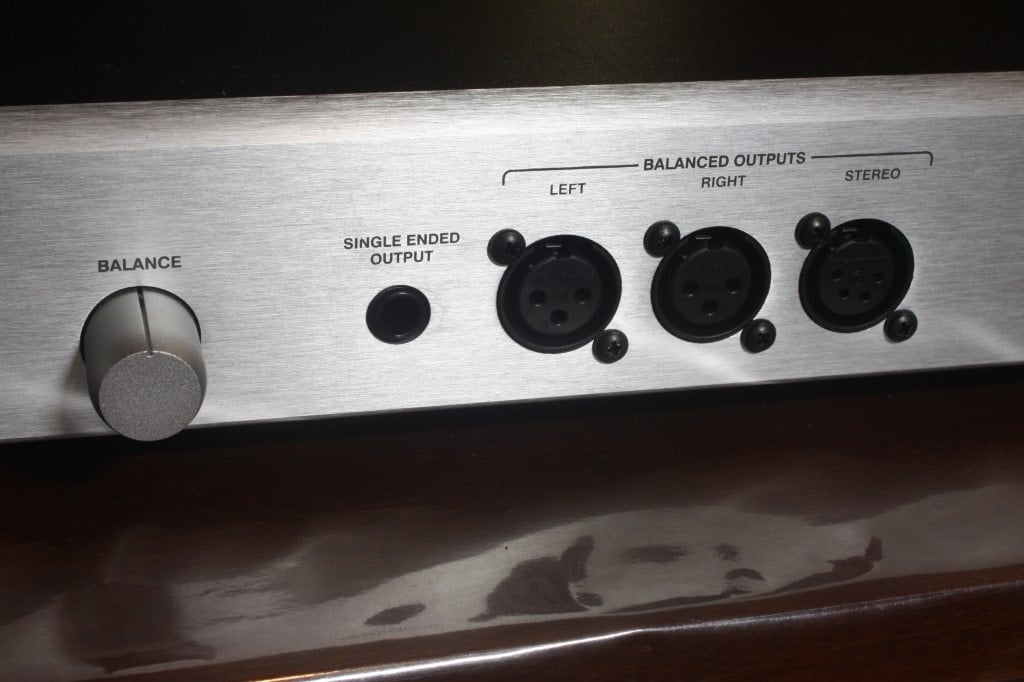
A typical headphone source (amplifier, DAP, etc.) supports an unbalanced headphone connection. Call up of that round ¼" headphone jack on your stereo or the iii.5mm socket on your (non-i) phone. Withal, information technology is condign much more than common for manufacturers to likewise include split up balanced headphone connections on their devices.

While once the purview of ultra-loftier-end or professional equipment, balanced connections have recently found their way to lower-priced consumer products. The idea, however, isn't a new one. In fact, the HeadRoom Blockhead counterbalanced headphone amplifier was introduced fashion back in 1999.
Unless a connection or device is specifically labeled as 'balanced output', information technology is safe to assume it just supports an unbalanced headphone connection.
To confuse matters, some amplifiers will have outputs that are labeled balanced and unmarried-concluded, rather than counterbalanced and unbalanced. So what's unmarried-ended and is information technology different from unbalanced? To answer this question, we have to take a brusque detour through amplification theory.
Single-Ended or Differential? Unbalanced or Counterbalanced?
All amplifiers follow one of two basic circuit structures related to how they treat signals and grounds: single-ended or differential.
One bones amplifier circuit structure is referred to equally single-concluded. In a single-concluded amplifier, the betoken ever remains whole and is handled in its entirety past the amplifying devices (tubes or transistors). In this type of circuit structure, we unremarkably have two of import voltage references: the signal itself and ground.
The other basic amplifying structure is referred to as differential (or push-pull). A differential amplifier has pairs of devices, with each half of a pair amplifying reverse phases of the bespeak. Differential amplification tin achieve higher power and greater efficiency than single-ended amplification (given the same parts).
A differential amplifier only cares about the divergence between phases, then non-linearities, ability supply ripple, and interference tend to cancel one time the phases are recombined. The phases (positive and negative or hot and common cold) are the 2 of import voltage references for differential amplification.
All connections are unbalanced or balanced and all amplifiers are either single-ended or differential.
While single-ended amplifiers tend to have unbalanced connections and balanced outputs tend to be driven by differential amplifiers, these are not rules set in stone. This chart includes only a handful of ameliorate-known amplifiers, only hopefully illustrates the taxonomies involved.
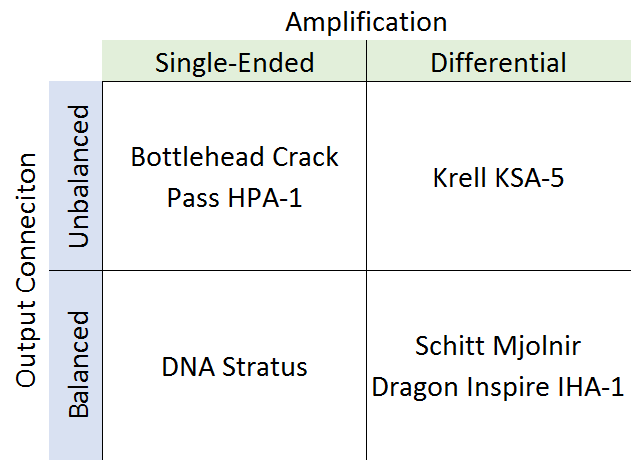
Our word of unbalanced and balanced connections refers to analog wired connections rather than digital. This means USB, SPDIF, and Bluetooth, etc. connections do not apply to this article.
Line-Level Connections
Unbalanced and balanced connections are possible between devices (for example: source or DAC to amplifier, including inputs and outputs) and too between a source or amplifier to headphones (output but). These connections aren't, in fact, the aforementioned.
The connectedness between devices is considered a line-level connection and is relatively standardized betwixt consumer devices, unlike the output connection to headphones.
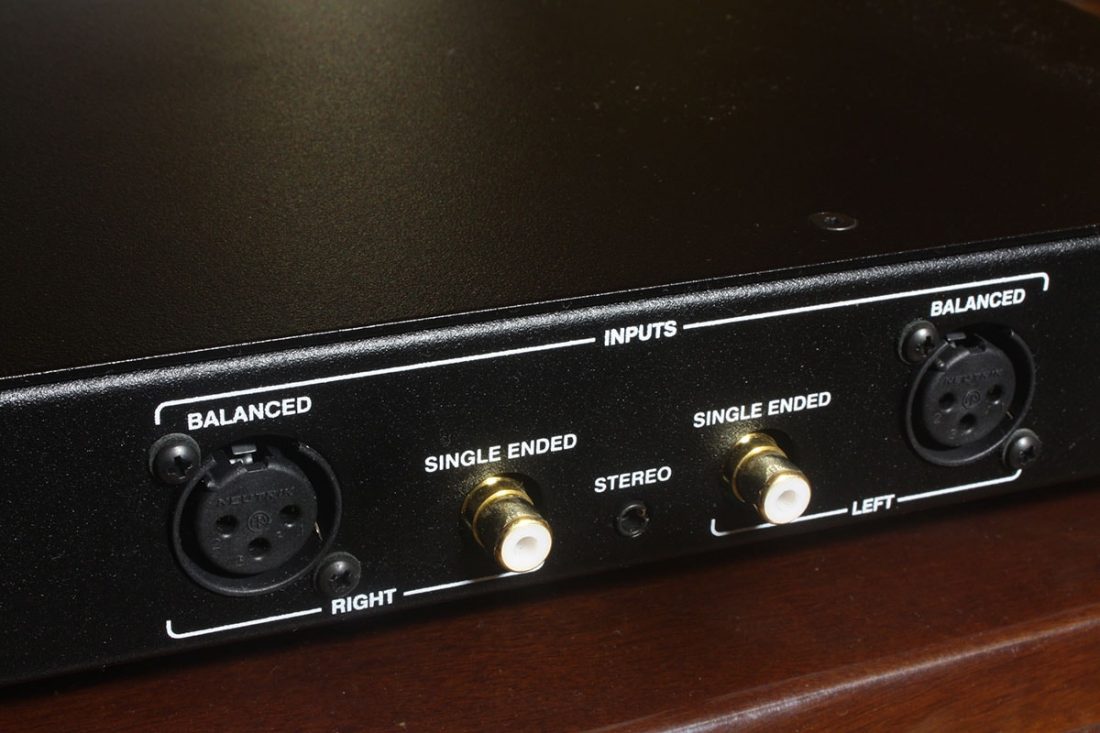
Unbalanced line-level connections are usually implemented with RCA jacks for sound, while balanced line-level connections typically utilize dual iii-pin XLR jacks for both the input and output. In both cases, i jack is normally used for each audio aqueduct (left and right).
"In these box-to-box line-level connections, a balanced interface can provide substantial performance improvements. Counterbalanced line-level interfaces reject hum and noise while providing a higher voltage level. The higher signal levels can amend the SNR (signal to dissonance ratio) of the sound system." – Benchmark Media Systems
Whether you meet these connections depends on the complexity of your personal setup and whether the source, DAC, and amp all are independent inside one integrated device or are connected via external cables. Certainly, balanced line-level connections commonly but appear on higher end gear.
The industry would like to equate balanced connections with expensive, high-end, and ultimate fidelity, yet, this isn't necessarily the case. In this article we volition discuss the technology behind balanced and unbalanced connections and if it makes an appreciable improvement, or even a difference, in sound quality.
Counterbalanced Amplifiers or Sources
Every bit explained before, the term "balanced amplifier" is something of a misnomer. Counterbalanced and unbalanced are types of interconnections betwixt devices; these terms do not refer to specific amplifier architectures. Usually when you see the phrase "balanced amplifier" it is referring to a differential amplifier without shared grounds and balanced outputs.
"A true Balanced amplifier will be balanced from input all the style through to the output. Opamp splitters are often used to convert the input and output from single-ended to balanced. There are plusses and minuses to this method. This is cheaper to produce merely it is not a truthful counterbalanced circuit and it may not audio equally good as if the entire chain would take been balanced." – Moon Audio
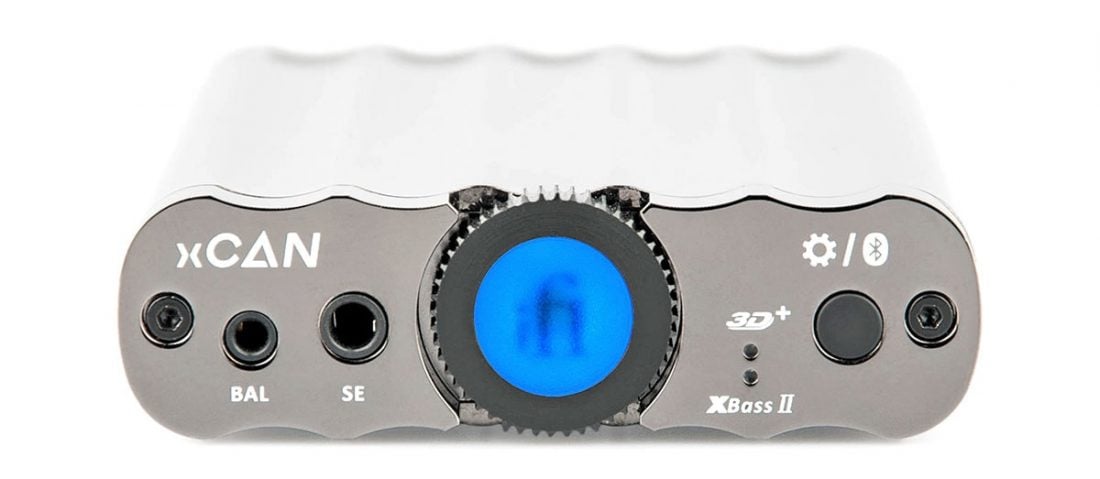
A truly balanced and differential signal path from source to load requires double the circuitry and is thus more expensive to manufacture, merely information technology can yield an aural improvement. This is sometimes referred to as 'dual-mono' to signal that each aqueduct is completely isolated from the other.
". Fully balanced internal circuitry has been promoted as yielding 3 dB better dynamic range, though at increased cost over single-ended designs." – Wikipedia
Unbalanced Connections
In the simplest terms, transferring an audio bespeak to a unmarried headphone driver requires a pair of wires to create a loop. This loop connects the audio source and the load (headphone driver). For a pair of headphones, in that location are two wires connected to each channel: left 'L' and right 'R'. Each pair of wires provides a voltage reference; information technology is the difference between these references that drives our headphones. It works the same fashion for line-level connections betwixt components.
Unbalanced connections derive their name from the relative impedance to ground of the two connections in each aqueduct: hot or positive '+' and ground or negative '-'. Considering the impedance to footing differs, we call the connection unbalanced.
In an unbalanced headphone setup, the ground connections for both sides are frequently tied together, so information technology is possible that the headphone cable may but consist of 3 wires: L, R and shared basis. All the same, most headphones of decent quality do take a separate wire from each negative concluding of the headphone driver through the length of the cable. These individual grounds are joined at the plug connector.
The most common type of headphone connector is unbalanced and has three contacts for the L+, R+ and shared -. This is known as a TRS (Tip, Ring, Sleeve) connector.
Drawbacks of Unbalanced Connections
A possible negative side effect of an unbalanced connection (line level or headphone) is the potential for unwanted noise, interference or hum to be introduced to the signal. Considering the ground is linked, wayward currents from power supply transformer leakages or devious capacitance can become role of the audio signal.
These currents can introduce undesirable audible hum or other interference in unbalanced connections. In addition, the shared footing betwixt unbalanced channels is blamed for crosstalk. Crosstalk is essentially unwanted signal leakage (or coupling) between audio channels. While crosstalk is ane of the basic sound measurements, be enlightened that information technology seldom causes aural issues in modern equipment.
These drawbacks led professional audio gear to require a different connection method to avoid unwanted noise or audio degradation. Thus, counterbalanced connections were born.
Balanced Connections
A counterbalanced connection has two betoken phases per channel. Each phase has an equal impedance relative to ground, hence the proper name balanced. The reward of balanced connections over unbalanced connections is mutual-mode racket rejection.
Information technology is called 'common mode' dissonance because the direction of the noise currents actualization simultaneously on the positive and negative sides is the aforementioned; a noise voltage differential does not announced beyond the 2 sides. Common-manner noise can generate Radio Frequency Interference (RFI) in cables.
Because any interference is imprinted as on the two phases' equal impedance, that mutual-mode interference cancels out. This tin be especially useful in professional person setups that require very long transmission cables (such as microphones) with low dissonance.
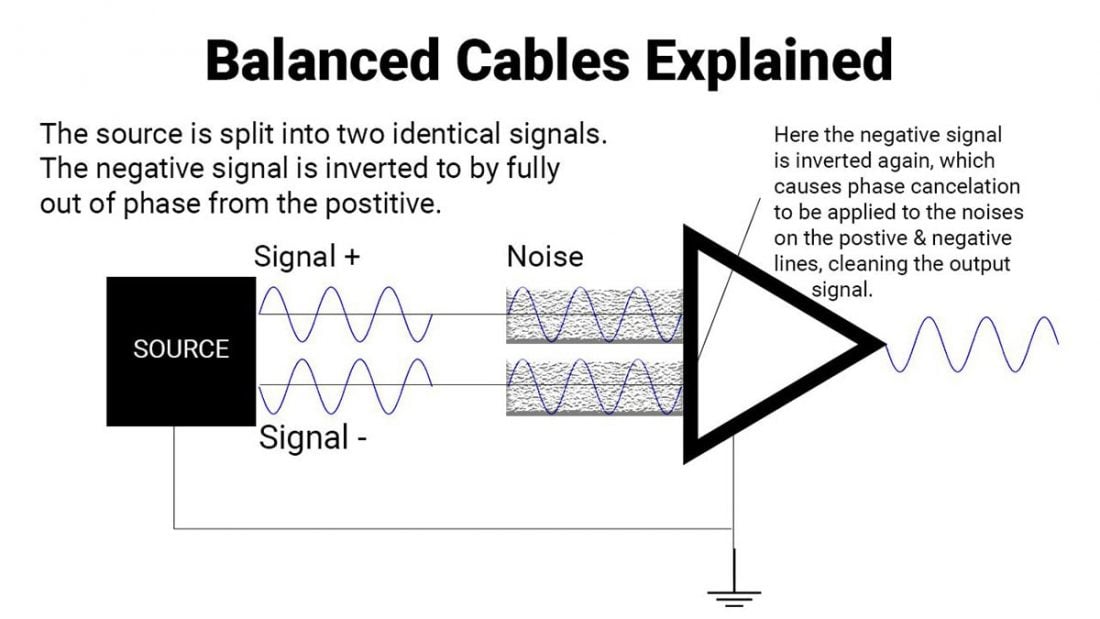
"Once more, 2 wires are used, but this fourth dimension instead of i carrying the (varying) indicate surrounded past one begetting the (constant) earth [ground], both of them carry the varying signal, except one carries a "mirror image" (180 degree out of phase) signal. Both wires are identical, usually twisted together, and there is no earth connectedness betwixt the units. The wire carrying the actual bespeak is normally termed "+", or "not-inverted", and the wire conveying the phase inverted signal is normally termed "-", or "inverted"." – Steve Hoffman Music Forums
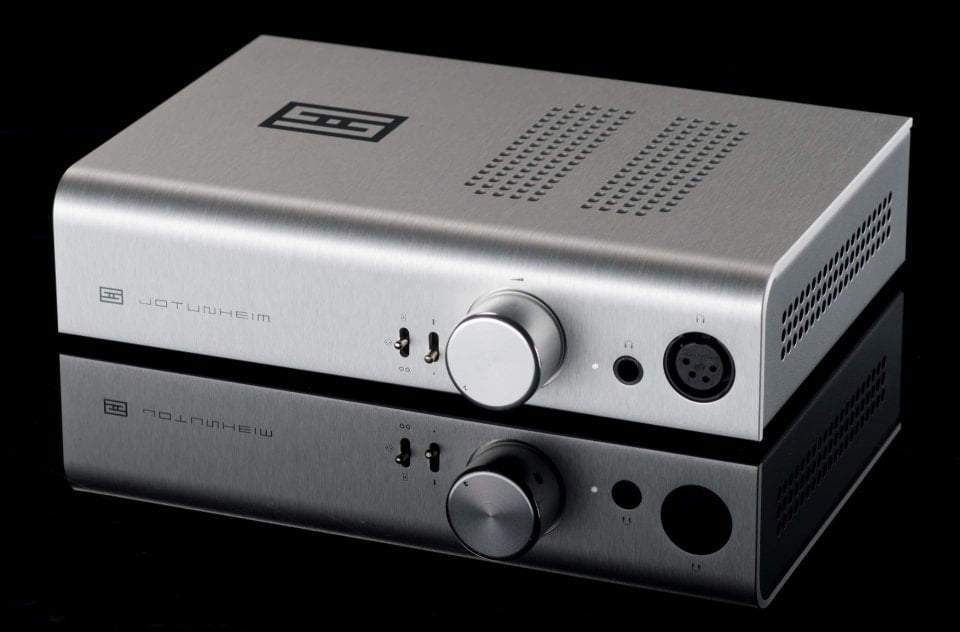
A Mathematical Look at Signal and Racket
In mathematical terms, we can accept a look at how noise is removed from a balanced connection.
Signal: S
Noise: N
Conductors: C1 and C2
| Unbalanced | Balanced |
|---|---|
| C1 = S and C2 = 0 | C1 = S/2 and C2 = -S/two |
- For an unbalanced connection, each signal travels along one conductor.
- For a balanced connection, each conductor contains half the signal out of phase.
When racket is added to each conductor, the equations in a higher place become:
| Unbalanced | Balanced |
|---|---|
| C1 = S + N and C2 = 0 | C1 = Due south/2 + N and C2 = -S/two + N C1 - C2 = (Southward/two + N) - (-South/2 + North) = 2S/2 + North - N = Southward |
- For an unbalanced connection, noise is added disproportionately to the loftier impedance signal conductor, resulting in a internet noise contribution on the output.
- For a balanced connectedness, noise is added to both phases equally and is canceled out, leaving merely the bespeak.
With unbalanced connections, any interference or dissonance introduced to the cable is picked up past the relatively loftier impedance signal conductor and is added to the output. With balanced connections, whatever interference or noise is as picked upwards only is canceled out at the output.
Drawbacks of Balanced Connections
At start glance, counterbalanced connections appear to have many advantages over unbalanced, so clearly counterbalanced must be the audiophile's choice! Unfortunately, cipher is quite as easy every bit information technology seems. Although in sure applications a balanced connectedness is, in fact, superior, information technology doesn't come up without drawbacks.
While balanced connections reduce hum and interference, the usual differential approaches to driving balanced outputs can also bear upon audio quality because the source output impedance is finer doubled. The random output racket will likewise double because there are two amplifiers rather than one.
"The damping factor volition degrade by a factor of 2 because both amplifiers contribute to the source impedance of the balanced amplifier (output impedance is doubled). Distortion will usually increase because each amplifier is required to drive half of the impedance that would be seen by an unbalanced amplifier." – Benchmark Media Systems
Counterbalanced differential connections and circuitry are by their very nature more complicated than unbalanced single-concluded. This tin can further introduce aural imperfections. Although the on-paper effects of the boosted circuitry are commonly considered inaudible, it is possible that the audio may be degraded due to how the circuitry is implemented.
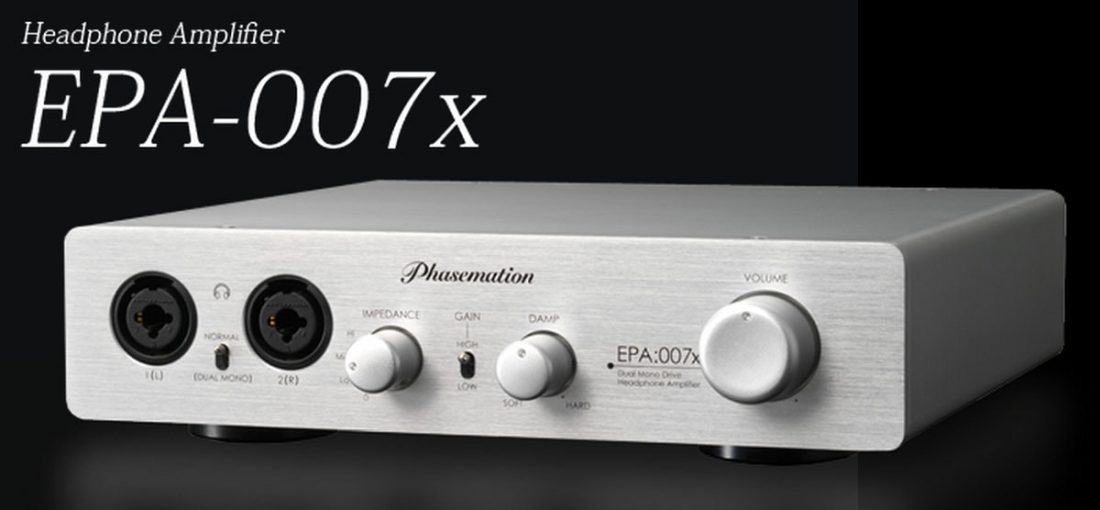
"…a voltage-balanced interface serves no useful purpose when driving headphones. The truth is that a conventional single-concluded headphone bulldoze is technically superior to a counterbalanced drive." – Benchmark Media Systems
The quality of the balanced circuitry implementation is paramount, else the theoretical benefits may not outweigh the potential problems of interference or dissonance with an unbalanced connection.
"Balanced audio is great for pro use with long cables and electrically hostile environments. But it'due south by and large more of a liability than an asset in abode audio gear. All else beingness equal, balanced stages usually have higher overall noise and distortion than their unbalanced counterparts. Headphone drivers don't magically somehow piece of work better when driven past a balanced source." – NwAvGuy
Balanced Connections Are More Powerful and Faster
A couple of things come up upward often when discussing the benefits of counterbalanced connections. Balanced provides more power and a faster response. While true, does this offer whatsoever real-globe advantages?
"…a balanced output can deliver iv times the power for a given power supply voltage… The balanced output would offer no existent reward in an Air-conditioning powered amplifier." – Benchmark Media Systems
While a vast improvement in power seems like an advantage, it is important to consider that more power doesn't equate to improved audio quality. If the headphone can exist driven hands by the amplifier, an abundance of ability doesn't necessarily offer any sonic benefits.
Counterbalanced proponents such as Headphone.com declare that "balanced-drive delivers a noted increase in audio performance due to the doubling of the amp's voltage slew charge per unit…". Slew rate speaks to the speed of an amplifier. It is defined equally the maximum rate at which an amplifier can answer to an abrupt change of input level.
Over again, it is important to consider that 'powerful enough' and 'fast enough' are real concepts. It is quite possible to blueprint components far beyond audible levels. If something isn't audible, further enhancing it yields no improvement. NwAvGuy goes further to say,
"…there's a myth faster slew rate is highly desirable and some DIY sites and forum members throw around impressive slew rate numbers. But a headphone amp but needs most 1 V/us of slew rate to handle any realistic indicate it will ever meet."
Headphone Cables and Connectors
It is of import to be able to recognize an unbalanced or counterbalanced headphone cable and connector. A counterbalanced cable tin be used in an unbalanced source with the proper adapter. All the same, attempting to employ an unbalanced cablevision with a balanced source is not possible, and will likely harm the source.
Headphone cables come with a variety of connectors, and it can be difficult for the uninitiated to differentiate betwixt counterbalanced and unbalanced. For the purpose of this give-and-take, nosotros are focussing on the end of the cable that plugs into the source, not into the headphones (as the headphone cup connector does non determine unbalanced or balanced; all headphone drivers are inherently balanced).
Types of Unbalanced Headphone Connectors
If the headphone cablevision comes with a standard 3-pole TRS stereo connector, it must exist unbalanced, regardless if information technology is a larger six.35 (¼") or smaller iii.5mm (⅛") connector. A 3-pole connection means the grounds are tied together and volition non piece of work with a balanced output.

It is not possible to catechumen an unbalanced headphone cablevision to a counterbalanced connectedness with an adapter as there is no way to untie these grounds. However, replacing the plug with a balanced connector is an option.
"For example, If you use an adapter cablevision from a female ¼" or ⅛" headphone jack to a balanced 4 pin XLR and connect this to a Balanced amp you are essentially shorting to footing 2 legs of the circuit making the amp single-ended. This can also potentially impairment your balanced amp depending on the design." – Moon Audio
Conversely, a counterbalanced headphone cable can be converted for use with an unbalanced output. This simply requires a compatible adapter that ties the two negative lines together and has a connector plug to fit the source.
It is quite common to detect 3.5mm TRRS connectors on unbalanced headphone cables. These cables typically contain a microphone wire. The fourth pole is not used for a balanced connection but as a channel for the mic, or sometimes as a video connection for Apple devices.

Balanced headphones and unbalanced headphones are the same things, differing only in the connector at the cease of the cablevision. To catechumen unbalanced headphones into counterbalanced, only re-cablevision with a dissimilar connector plug.
Types of Balanced Headphone Connectors
Traditionally 4-pin XLR connectors have been used for the connexion betwixt balanced headphone cables and a headphone amplifier. While appropriate in professional person audio situations where the larger size and tough structure are prized, XLRs make heavy and clumsy habitation headphone connectors. For portable devices, they are frankly ridiculous.
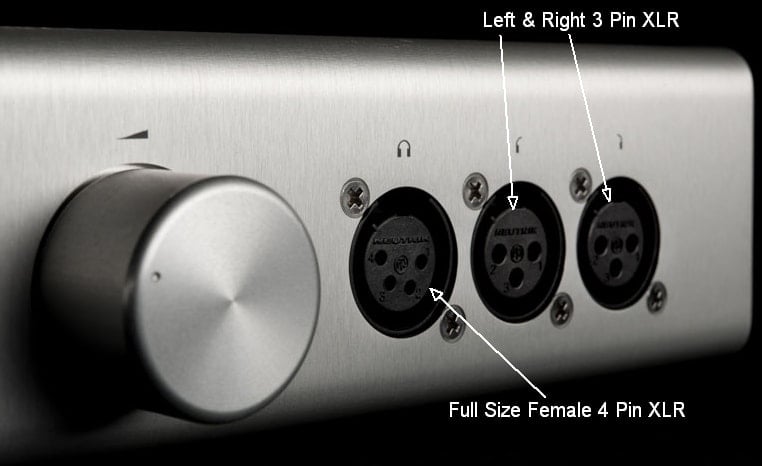
Some manufacturers adopt the 'more than is better' arroyo and actually utilise dual 3-pivot XLR connections betwixt a balanced headphone and the amplifier. One for each Left and Right channel (the aforementioned as is washed with line-level balanced interconnects).
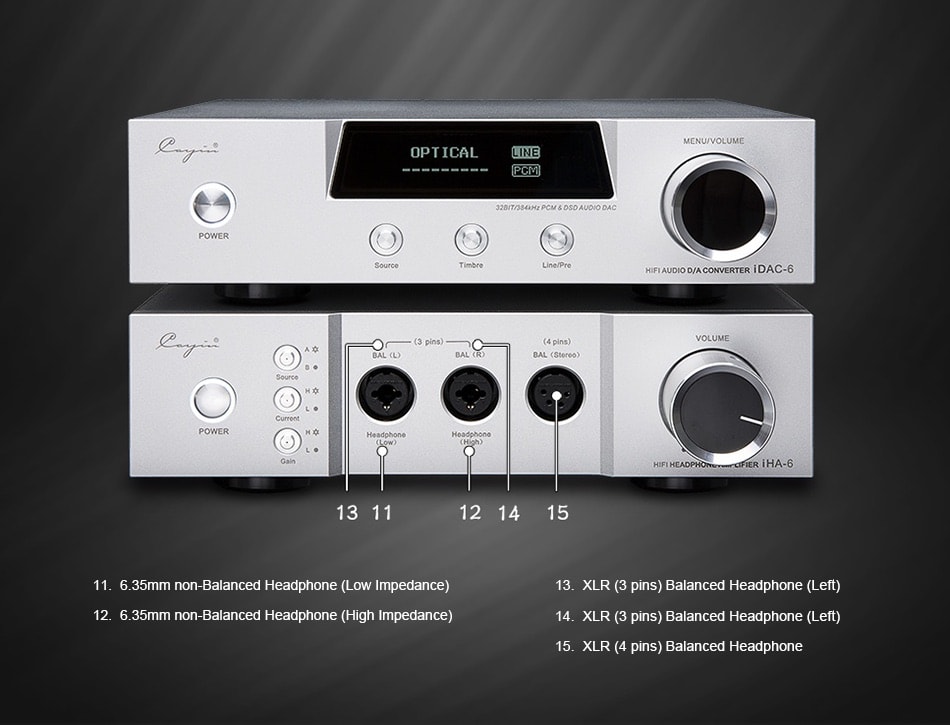
two.5mm TRRS connections are fast becoming the norm for portable counterbalanced headphone use. The smaller size not only is ideal for tiny devices, it also prohibits adventitious insertion of a single-concluded 3.5mm plug, and provides the 4 discrete poles necessary for balanced operation.
While not a headphone cablevision, it should be noted that a potential hum upshot can be introduced when connecting a portable source to a non-portable device with a true earth ground. For example, a bombardment-operated DAC or DAP connected to a home headphone amplifier. While not an issue with unbalanced connections, using a 4-pole balanced connection (such as the two.5mm TRRS) tin can produce unwanted racket due to differences between ground references.
"There is a new connection that nosotros are hoping gets adopted by more manufacturers. Information technology is chosen the iv.4mm TRRS. This plug has v contacts for a balanced connection and the 5th contact eliminates the grounding issue. Sony is pushing this connection and some companies are starting to adopt it like Sennheiser. Nosotros have adopted information technology on our audio cables and volition exist implementing it on future Headphone Amp designs." – Moon Sound
Every bit you may have guessed, lack of standardization is certainly a factor with balanced connectors, leading to a plethora of adapters and plenty of defoliation. There are seven unlike types of balanced connections for headphones and an additional one specifically for electrostatic headphones:
- four-pin XLR (common non-portable headphone amplifier standard)
- Dual three-pin (standard) XLR
- Mini 4-pin XLR
- TRRS iii.5mm (used on balanced cup connectedness on Oppo PM-iii, Hifiman HM-901 and Geek Out v2)
- TRRS 2.5mm (used past Astell and Kern, Onkyo, HiFiMan and Footling Bear)
- Kobicon miniature 4-pin Auto-IRIS (relatively rare but found on Ray Samuels RSA and Centrance balanced headphone amps)
- 5-pole 4.4mm Pentaconn (used past Sony)
- 5-pole connector for electrostatic headphones
Balanced Connection examples from DIY Audio Blog:
Decision
As nosotros have seen, there is no simple, clear-cutting answer for whether unbalanced or counterbalanced is a superior connection over the other. Whether a balanced connection provides an advantage depends on the circuits within a device and what provides the best signal path with the least degradation. In this fashion, the source, rather than the headphones, is the disquisitional component.
In truth, a well designed single-ended amplifier featuring unbalanced connections is capable of truly excellent sound performance. Certainly, information technology can be superior to a poorly implemented balanced design. The changed is likewise true.
Usually, the only thing that differentiates the headphones themselves every bit unbalanced or balanced is the connector plug on the cable. Since many headphones accept socketed user-replaceable cables, there are a ton of available options out there.
Even if the cable is fixed to the headphone cup, the cable connector tin can often be replaced with a balanced connector, and a simple adapter can be used at that indicate to swap between balanced and unmarried-ended sources. This is exactly what was done with my own Beyerdynamic T1 headphones.
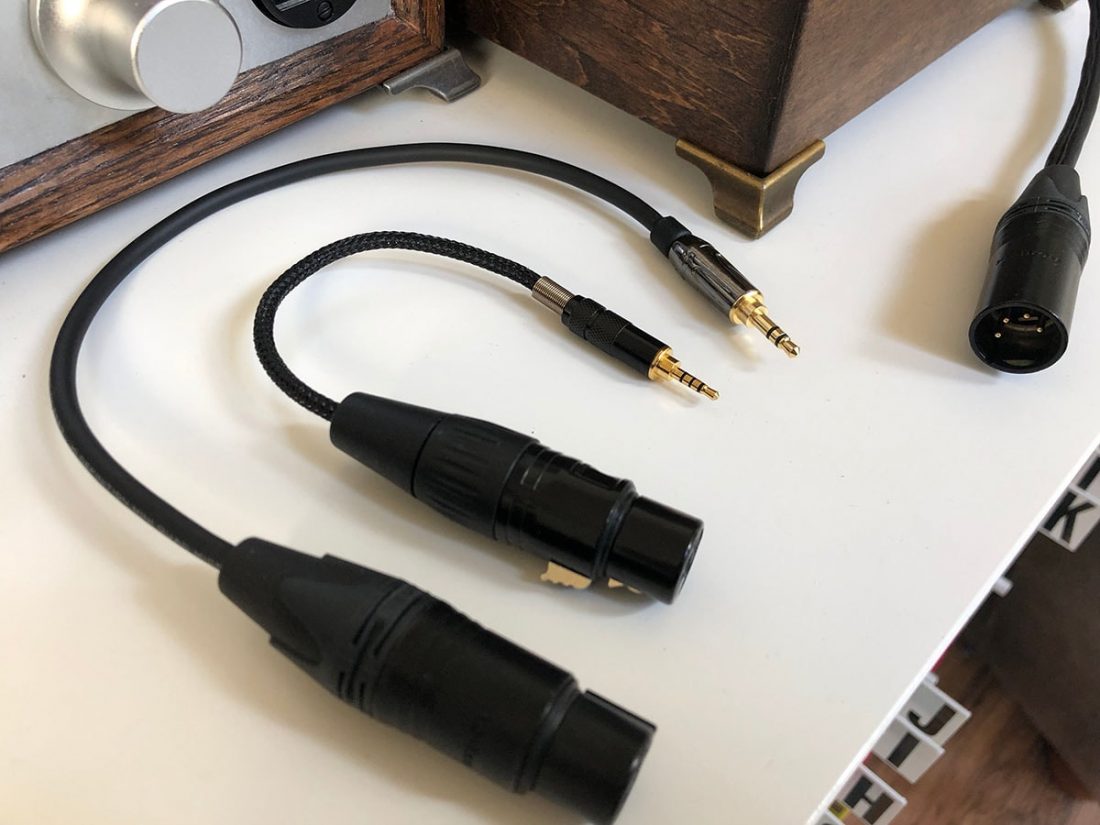
Balanced has clear advantages in professional audio applications and noisy environments, but for us headphone enthusiasts, it really is going to come up down to the individual component (or components) in the audio concatenation. There are as as many cases where properly implemented elementary unbalanced solutions (rather than balanced) will be the clear winner.
It's far too piece of cake to get swept upwardly in a case of 'upgradeitis', where chasing every tweak and hyped potential improvement is the norm. Just because you read a manufacturer'due south claim or heard from an online audiophile guru that balanced is 'e'er superior', doesn't make it a fact in all (or possibly fifty-fifty nigh) cases.
If your source has the option of both unbalanced and balanced outputs, nothing beats trying them both yourself. Listen. Go with what sounds amend to you. That's the 'right' answer to which connection is superior.
Source: https://www.headphonesty.com/2019/05/balanced-vs-unbalanced-audio-connections/
0 Response to "To Listen to the Radio Again Switch the Audio Input Source to the Radio When It Is Safe to Do So"
Post a Comment